Animal Kingdom 1000+ MCQ with answer for GMAT
Thursday 9th of March 2023

Sharing is caring
1. Which of the following statement(s) is/are correct?
(i) Animals in which the cells are arranged in two embryonic layers, an external ectoderm and an internal endoderm, are called diploblastic animals.
(ii) Notochord is an ectodermally derived rod like structure formed on the ventral side during embryonic development in some animals.
(iii) In some animals, the body cavity is not lined by mesoderm, instead, the mesoderm is present as scattered pouches in between the ectoderm and endoderm and such a body cavity is called pseudocoelom.
A. Only (i)
B. Both (i) and (ii)
C. Both (i) and (iii)
D. All of these
Answer : C
(i) Animals in which the cells are arranged in two embryonic layers, an external ectoderm and an internal endoderm, are called diploblastic animals.
(ii) Notochord is an ectodermally derived rod like structure formed on the ventral side during embryonic development in some animals.
(iii) In some animals, the body cavity is not lined by mesoderm, instead, the mesoderm is present as scattered pouches in between the ectoderm and endoderm and such a body cavity is called pseudocoelom.
A. Only (i)
B. Both (i) and (ii)
C. Both (i) and (iii)
D. All of these
Answer : C
2. Which of the following class is being described by the given statements (i - iv)?
(i) They are found in a variety of habitats- polar ice-caps, deserts, mountains, forests, grasslands and dark caves.
(ii) Most unique mammalian characteristic is the presence of mammary glands by which the young ones are nourished.
(iii) Heart is four-chambered.
(iv) Sexes are separate and fertilization is internal.
A. Reptilia
B. Aves
C. Mammalia
D. Amphibia
Answer : C
(i) They are found in a variety of habitats- polar ice-caps, deserts, mountains, forests, grasslands and dark caves.
(ii) Most unique mammalian characteristic is the presence of mammary glands by which the young ones are nourished.
(iii) Heart is four-chambered.
(iv) Sexes are separate and fertilization is internal.
A. Reptilia
B. Aves
C. Mammalia
D. Amphibia
Answer : C
3. Which of the following animal's body is covered by calcareous shell and unsegmented with a distinct head, muscular foot, and visceral hump?
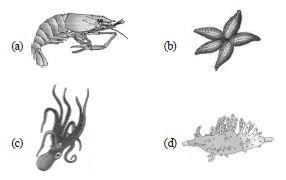
A. Click to check answer
B. Click to check answer
C. Click to check answer
D. Click to check answer
Answer : C

A. Click to check answer
B. Click to check answer
C. Click to check answer
D. Click to check answer
Answer : C
4. Aquatic annelids (like Nereis) possess lateral appendages called ______________, which help in swimming.
A. visceral hump
B. parapodia
C. radula
D. spicules
Answer : B
A. visceral hump
B. parapodia
C. radula
D. spicules
Answer : B
5. Which of the following feature is not correct regarding the figure given below?

A. It is an aquatic form.
B. Circulatory system is of open type.
C. It possesses parapodia for swimming.
D. Neural system consists of paired ganglia connected by lateral nerves to a double ventral nerve cord.
Answer : B

A. It is an aquatic form.
B. Circulatory system is of open type.
C. It possesses parapodia for swimming.
D. Neural system consists of paired ganglia connected by lateral nerves to a double ventral nerve cord.
Answer : B
6. Which of the following animal contains respiratory organs like, gills, book gills, book lungs or tracheal system?
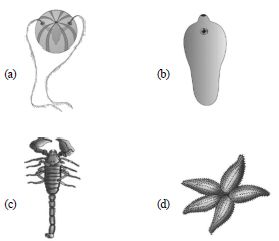
A. Click to check answer
B. Click to check answer
C. Click to check answer
D. Click to check answer
Answer : C

A. Click to check answer
B. Click to check answer
C. Click to check answer
D. Click to check answer
Answer : C
7. Which of the following class is being correctly described by given statements (i - iv)?
(i) All living members of this class are ectoparasites on some fishes.
(ii) They have a sucking and circular mouth without jaws.
(iii) Circulation is of closed type.
(iv) They are marine but migrate for spawning to fresh water. After spawing, within a few days they die.
A. Cyclostomata
B. Chondrichthyes
C. Osteichthyes
D. Amphibia
Answer : A
(i) All living members of this class are ectoparasites on some fishes.
(ii) They have a sucking and circular mouth without jaws.
(iii) Circulation is of closed type.
(iv) They are marine but migrate for spawning to fresh water. After spawing, within a few days they die.
A. Cyclostomata
B. Chondrichthyes
C. Osteichthyes
D. Amphibia
Answer : A
8. Identify the figure with its correct name and phylum.
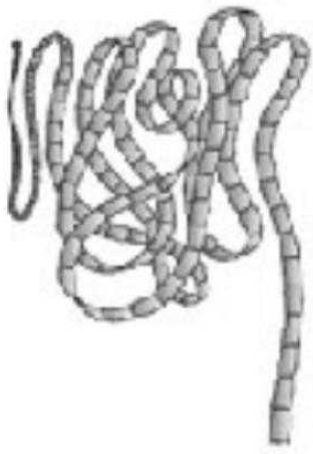
A. Sycon - Porifera
B. Aurelia - Coelenterata
C. Pleurobrachia - Ctenophora
D. Tapeworm - Platyhelminthes
Answer : D

A. Sycon - Porifera
B. Aurelia - Coelenterata
C. Pleurobrachia - Ctenophora
D. Tapeworm - Platyhelminthes
Answer : D
9. Which of the following statement(s) is/are correct regarding phylum coelenterata?
(i) They are aquatic, mostly marine, sessile or freeswimming, radially symmetrical animals.
(ii) They have a central gastro-vascular cavity with a single opening called hypostome.
(iii) Digestion is extracellular and intracellular.
(iv) Examples are Sycon, Spongilla and Euspongia.
A. (i) and (ii)
B. (i) and (iv)
C. (i), (ii) and (iii)
D. All of these
Answer : C
(i) They are aquatic, mostly marine, sessile or freeswimming, radially symmetrical animals.
(ii) They have a central gastro-vascular cavity with a single opening called hypostome.
(iii) Digestion is extracellular and intracellular.
(iv) Examples are Sycon, Spongilla and Euspongia.
A. (i) and (ii)
B. (i) and (iv)
C. (i), (ii) and (iii)
D. All of these
Answer : C
10. Which of the following statement(s) is/are correct regarding phylum mollusca?
A. They are bilaterally symmetrical, triploblastic and coelomate animals.
B. Body is covered by a calcareous shell and is unsegmented with a distinct head, muscular foot and visceral hump.
C. The mouth contains a file-like rasping organ for feeding, called radula.
D. All of the above
Answer : D
A. They are bilaterally symmetrical, triploblastic and coelomate animals.
B. Body is covered by a calcareous shell and is unsegmented with a distinct head, muscular foot and visceral hump.
C. The mouth contains a file-like rasping organ for feeding, called radula.
D. All of the above
Answer : D
11. Identify the animals shown in the given figures A, B and C from options given below.

A. A - Octopus; B -Asterias, C- Ophiura
B. A - Asterias; B - Ophiura, C- Octopus
C. A - Echinus; B - Octopus C - Ophiura
D. A - Ophiura; B - Echinus, C- Octopus
Answer : A

A. A - Octopus; B -Asterias, C- Ophiura
B. A - Asterias; B - Ophiura, C- Octopus
C. A - Echinus; B - Octopus C - Ophiura
D. A - Ophiura; B - Echinus, C- Octopus
Answer : A
12. Refer the figures A, B, C and D given below. Which of the following options shows the correct name of the animals shown by the figures A, B, C and D ?

A. A – Locust, B – Scorpion, C – Prawn, D – Pila
B. A – Locust, B – Prawn, C – Scorpion, D – Pila
C. A – Locust, B – Scorpion, C – Prawn, D – Snail
D. A – Butterfly, B – Scorpion, C – Prawn, D – Pila
Answer : A

A. A – Locust, B – Scorpion, C – Prawn, D – Pila
B. A – Locust, B – Prawn, C – Scorpion, D – Pila
C. A – Locust, B – Scorpion, C – Prawn, D – Snail
D. A – Butterfly, B – Scorpion, C – Prawn, D – Pila
Answer : A
13. Match the organisms given in column-I with their common name given in column-II and choose the correct option.
A. A II; C III; D I; E IV
B. A II; C IV; D I; E III
C. A II; C I; D III; E IV
D. A II; C I; D III; E IV
Answer : C
| Column -I | Column -II |
|---|---|
| (Organisms) | (Comman name) |
| A. Pennatula | I. Sea-lily |
| B. Antedon | II. Sea- pen |
| C. Echinus | III. Sea-urchin |
| D. Cucumaria | IV. Sea - cucumber |
A. A II; C III; D I; E IV
B. A II; C IV; D I; E III
C. A II; C I; D III; E IV
D. A II; C I; D III; E IV
Answer : C
14. In amphibians, heart is ________ chambered.
A. two
B. three
C. four
D. none of thes
Answer : B
A. two
B. three
C. four
D. none of thes
Answer : B
15. In phylum arthropoda, excretion takes place through
A. nephridia
B. flame cells
C. malphigian tubules
D. gills
Answer : C
A. nephridia
B. flame cells
C. malphigian tubules
D. gills
Answer : C
16. A common characteristic of all vertebrates without exception is
A. the division of body into head, neck, trunk and tail.
B. body covered with exoskeleton.
C. the possession of two pairs of functional appendages.
D. the presence of well- developed skull.
Answer : D
A. the division of body into head, neck, trunk and tail.
B. body covered with exoskeleton.
C. the possession of two pairs of functional appendages.
D. the presence of well- developed skull.
Answer : D
17. Which of the following is an incorrect statement regarding flatworms ?
A. They are acoelomates.
B. They are bilaterally symmetrical.
C. They lack a digestive system.
D. They have a circulatory system.
Answer : D
A. They are acoelomates.
B. They are bilaterally symmetrical.
C. They lack a digestive system.
D. They have a circulatory system.
Answer : D
18. Read the following statements and answer the question.
(i) They are exclusively marine, radially symmetrical, diploblastic organisms with tissue level of organisation.
(ii) Body bears eight external rows of ciliated comb plates, which help in locomotion.
(iii) Digestion is both extracellular and intracellular.
(iv) Reproduction takes place only by sexual means.
Which of the following phylum is being described by above statements?
A. Platyhelminthes
B. Arthropoda
C. Mollusca
D. Ctenophora
Answer : D
(i) They are exclusively marine, radially symmetrical, diploblastic organisms with tissue level of organisation.
(ii) Body bears eight external rows of ciliated comb plates, which help in locomotion.
(iii) Digestion is both extracellular and intracellular.
(iv) Reproduction takes place only by sexual means.
Which of the following phylum is being described by above statements?
A. Platyhelminthes
B. Arthropoda
C. Mollusca
D. Ctenophora
Answer : D
19. Refer the types of cells present in some animals. Each cell is specialized to perform a single specific function except
A. Cnidocytes
B. Choanocytes
C. Interstitial cells
D. Gastrodermal cells
Answer : C
A. Cnidocytes
B. Choanocytes
C. Interstitial cells
D. Gastrodermal cells
Answer : C
20. When any plane passing through the central axis of the body divides the organism into two identical halves, the organism is called ___________.
A. radially symmetrical
B. bilaterally symmetrical
C. asymmetrical
D. metamerically segmented
Answer : A
A. radially symmetrical
B. bilaterally symmetrical
C. asymmetrical
D. metamerically segmented
Answer : A
21. Flame cells present in platyhelminthes, are specialized in
A. respiration and absorption.
B. osmoregulation and circulation.
C. respiration and excretion.
D. osmoregulation and excretion.
Answer : D
A. respiration and absorption.
B. osmoregulation and circulation.
C. respiration and excretion.
D. osmoregulation and excretion.
Answer : D
22. Identify the correct characteristic feature shown by the given figure?

A. Diploblastic in nature.
B. Having radial symmetrical body.
C. Dioecious with direct development.
D. Presence of sensory tentacles on anterior head region.
Answer : D

A. Diploblastic in nature.
B. Having radial symmetrical body.
C. Dioecious with direct development.
D. Presence of sensory tentacles on anterior head region.
Answer : D
23. Identify the figure with its correct name and phylum.

A. Cucumaria – Echinodermata
B. Ascidia – Urochordata
C. Balanoglossus – Hemichordata
D. Hirudinaria – Annelida
Answer : C

A. Cucumaria – Echinodermata
B. Ascidia – Urochordata
C. Balanoglossus – Hemichordata
D. Hirudinaria – Annelida
Answer : C
24. Refer the figures A, B and C and choose the correct option which shows animals that regulate buoyancy with the help of air bladder.
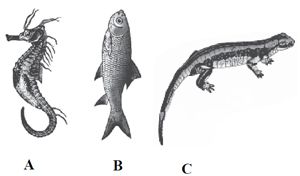
A. A and B
B. A and C
C. B and C
D. All of the above.
Answer : A

A. A and B
B. A and C
C. B and C
D. All of the above.
Answer : A
25. Select the incorrect feature of mollusca from the given statements.
A. (i) and (ii) only
B. (ii) and (iv) only
C. (i), (ii) and (iv) only
D. All the five statements.
Answer : C
- Terrestrial or aquatic animals having cellular system level of organization.
- Radial symmetrical and acoelomate animals and possesses two germinal layers.
- A file like rasping organ called radula is present.
- Usually dioecious and viviparous animals.
- Examples include Pila, Octopus, and Dentalium.
A. (i) and (ii) only
B. (ii) and (iv) only
C. (i), (ii) and (iv) only
D. All the five statements.
Answer : C
26. Which of the following characteristic distinguish arthropoda from annelids and molluscs ?
A. An external skeleton made of chitin (a polysaccharide) and protein rather than a shell made chiefly of mineral salts.
B. Subdivision of the legs into movable segments.
C. Distinct group of muscles, derived from many body segments, that move the separate parts of the exoskeleton.
D. All of the above
Answer : D
A. An external skeleton made of chitin (a polysaccharide) and protein rather than a shell made chiefly of mineral salts.
B. Subdivision of the legs into movable segments.
C. Distinct group of muscles, derived from many body segments, that move the separate parts of the exoskeleton.
D. All of the above
Answer : D
27. Which of the following phylum is being described by the given statements?
(i) They are bilaterally symmetrical,triploblastic, segmented and coelomate animals.
(ii) The body consists of head, thorax, abdomen and have jointed appendages.
(iii) Circulatory system is of open type.
(iv) Excretion takes place through malphigian tubules.
A. Arthropoda
B. Annelida
C. Mollusca
D. Echinodermata
Answer : A
(i) They are bilaterally symmetrical,triploblastic, segmented and coelomate animals.
(ii) The body consists of head, thorax, abdomen and have jointed appendages.
(iii) Circulatory system is of open type.
(iv) Excretion takes place through malphigian tubules.
A. Arthropoda
B. Annelida
C. Mollusca
D. Echinodermata
Answer : A
28. Match the phylum given in column - I with their example given in column - II and choose the correct option.
A. A IV; B II; C I; D III
B. A II; B IV; C I; D III
C. A II; B IV; C III; D I
D. A II; B I; C IV; D III
Answer : B
| Column -I | Column- II |
|---|---|
| (Phylum) | (Examples) |
| A. Echinodermata | I. Ascidia, Doliolum |
| B. Hemichordata | II. Asterias, Ophiura |
| C. Urochordata | III. Branchiostoma |
| D. Cephalochordata | IV. Balanoglossus, Saccoglossus |
A. A IV; B II; C I; D III
B. A II; B IV; C I; D III
C. A II; B IV; C III; D I
D. A II; B I; C IV; D III
Answer : B
29. Which of the following statements is incorrect ?
A. Prawn has two pairs of antennae.
B. Nematocysts are characteristic feature of the phylum cnidaria.
C. Millipedes have two pairs of appendages in each segment of the body.
D. Animals that belong to phylum porifera are exclusively marine.
Answer : D
A. Prawn has two pairs of antennae.
B. Nematocysts are characteristic feature of the phylum cnidaria.
C. Millipedes have two pairs of appendages in each segment of the body.
D. Animals that belong to phylum porifera are exclusively marine.
Answer : D
30. Animals like annelids, arthropods, etc. where the body can be divided into identical left and right halves in only one plane, exhibit___________symmetry.
A. radial
B. bilateral
C. asymmetrical
. non- symmetrical
Answer : A
A. radial
B. bilateral
C. asymmetrical
. non- symmetrical
Answer : A
31. Refer the following statement and answer the question. 'Name of X is derived from stinging capsules. It exhibits metagenesis containing two body forms in which sessile and cylindrical form is called Y and umbrella shaped and free swimming is called Z. Identify X, Y, and Z.
A. X - Coelenterate, Y - Polyp, Z - Medusa
B. X - Cnidarian, Y - Medusa, Z - Polyp
C. X - Ctenophora, Y - Radula, Z - Hypostome
D. X - Porifera, Y - Osculum, Z - Radula
Answer : A
A. X - Coelenterate, Y - Polyp, Z - Medusa
B. X - Cnidarian, Y - Medusa, Z - Polyp
C. X - Ctenophora, Y - Radula, Z - Hypostome
D. X - Porifera, Y - Osculum, Z - Radula
Answer : A
32. The figure given below shows the germinal layers marked as A, B, C and D. Identify the label showing undifferentiated layer and its location?
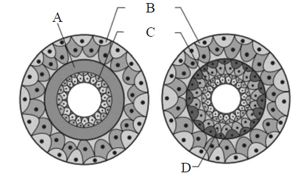
A. A, Between B & C
B. B, Between A & C
C. C, Between C & D
D. D, Between A & B
Answer : A

A. A, Between B & C
B. B, Between A & C
C. C, Between C & D
D. D, Between A & B
Answer : A
33. Meandrina (brain coral) belongs to phylum
A. porifera
B. coelenterata
C. ctenophora
D. platyhelminthes
Answer : B
A. porifera
B. coelenterata
C. ctenophora
D. platyhelminthes
Answer : B
34. Which of the following is a correct match of a phylum with their three examples?
A. PlatyhelminthesPlanaria, Schistosoma, Enterobius
B. Mollusca Loligo, Sepia, Octopus
C. Porifera Spongilla, Euplectella, Pennatula
D. Cnidaria Bonellia, Physalia, Aurelia
Answer : B
A. PlatyhelminthesPlanaria, Schistosoma, Enterobius
B. Mollusca Loligo, Sepia, Octopus
C. Porifera Spongilla, Euplectella, Pennatula
D. Cnidaria Bonellia, Physalia, Aurelia
Answer : B
35. The given figures A, B, C and D are the examples of first true land vertebrates. They are dominant in mesozoic era and belong to phylum ‘X’. Identify ‘X’ and the animals which have four chambered heart.
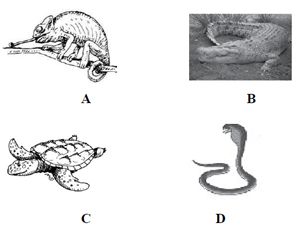
A. X – Reptile; B
B. X – Reptile; A
C. X – Amphibia, C
D. X – Pisces; D
Answer : A

A. X – Reptile; B
B. X – Reptile; A
C. X – Amphibia, C
D. X – Pisces; D
Answer : A
36. Which of the following statements (i v) are incorrect?
(i) Parapodia are lateral appendages in arthropods used for swimming.
(ii) Radula in molluscs are structures involved in excretion.
(iii) Aschelminthes are dioecious.
(iv) Echinoderm adults show radial symmetry.
(v) Ctenophorans are diploblastic.
A. (i) and (ii)
B. (i) and (iii)
C. (i), (iv) and (v)
D. (iii) and (v)
Answer : A
(i) Parapodia are lateral appendages in arthropods used for swimming.
(ii) Radula in molluscs are structures involved in excretion.
(iii) Aschelminthes are dioecious.
(iv) Echinoderm adults show radial symmetry.
(v) Ctenophorans are diploblastic.
A. (i) and (ii)
B. (i) and (iii)
C. (i), (iv) and (v)
D. (iii) and (v)
Answer : A
37. Which of the following group of animals belongs to the same phylum?
A. Earthworm, pinworm, tapeworm
B. Prawn, scorpion, Locusta
C. Sponge, Sea anemone, starfish
D. Malarial parasite, Amoeba, mosquito
Answer : B
A. Earthworm, pinworm, tapeworm
B. Prawn, scorpion, Locusta
C. Sponge, Sea anemone, starfish
D. Malarial parasite, Amoeba, mosquito
Answer : B
38. Match the types of animals given in column I with their examples given in column II and choose the correct option.
A. A II; B V; C IV; D I; E III
B. A V; B II; C IV; D I; E III
C. A V; B II; C I; D IV; E III
D. A V; B IV; C II; D I; E III
Answer : B
| Column -I | Column -II |
|---|---|
| (Types of animals) | (Examples) |
| A. Limbless reptiles | I. Elephant |
| B. Jawless vertebrates | II. Lamprey |
| C. Flightless bird | III. Ichthyophis |
| D. Largest | IV. Ostrich terrestrial animal |
| E. Limbless amphibia | V. Cobra |
A. A II; B V; C IV; D I; E III
B. A V; B II; C IV; D I; E III
C. A V; B II; C I; D IV; E III
D. A V; B IV; C II; D I; E III
Answer : B
39. Tracheae of cockroach and mammal are similar in having
A. paired nature.
B. non-collapsible walls.
C. ciliated inner lining.
D. origin from head.
Answer : B
A. paired nature.
B. non-collapsible walls.
C. ciliated inner lining.
D. origin from head.
Answer : B
40. Which of the following is a connecting link between invertebrates and non-invertebrates?
A. Sphenodon
B. Balanoglossus
C. Tadpole larva
D. Crocodile
Answer : B
A. Sphenodon
B. Balanoglossus
C. Tadpole larva
D. Crocodile
Answer : B
41. Which of the following characteristics is correct for reptilia?
A. Body covered with dry and cornified skin, scales over the body are epidermal, they do not have external ears.
B. Body is covered with moist skin and is devoid of scales, the ear is represented by a tympanum, alimentary canal, urinary and reproductive tracts open into a common cloaca.
C. Fresh water animals with bony endoskeleton and airbladder regulate buoyancy.
D. Marine animals with cartilaginous endoskeleton and body is covered with placoid scales.
Answer : A
A. Body covered with dry and cornified skin, scales over the body are epidermal, they do not have external ears.
B. Body is covered with moist skin and is devoid of scales, the ear is represented by a tympanum, alimentary canal, urinary and reproductive tracts open into a common cloaca.
C. Fresh water animals with bony endoskeleton and airbladder regulate buoyancy.
D. Marine animals with cartilaginous endoskeleton and body is covered with placoid scales.
Answer : A
42. Which of the following is not a characteristic of phylum echinodermata ?
A. They have a water vascular system.
B. They have an internal skeleton.
C. They are protostomes.
D. They have bilateral symmetry at larval stage.
Answer : C
A. They have a water vascular system.
B. They have an internal skeleton.
C. They are protostomes.
D. They have bilateral symmetry at larval stage.
Answer : C
43. Few cnidarians like corals have a skeleton composed of
A. calcium hydroxide
B. calcium sulphate
C. calcium carbonate
D. sodium bicarbonate
Answer : C
A. calcium hydroxide
B. calcium sulphate
C. calcium carbonate
D. sodium bicarbonate
Answer : C
44. Which of the following feature in birds indicates their reptilian ancestory ?
A. Eggs with a calcareous shell
B. Scales on their hind limbs
C. Four-chambered heart
D. Two special chambers-crop and gizzard in their digestive tract
Answer : C
A. Eggs with a calcareous shell
B. Scales on their hind limbs
C. Four-chambered heart
D. Two special chambers-crop and gizzard in their digestive tract
Answer : C
45. Identify the figures A, B and C and choose the correct option.

A. A - Male Ascaris, B - Hirudinaria (leech), C- Nereis
B. A - Female Ascaris, B - Nereis, C-Hirudinaria (leech)
C. A - Female Ascaris B- Hirudinaria (leech), C - Nereis
D. A - Male Ascaris, B - Nereis, C- Hirudinaria (leech)
Answer : B

A. A - Male Ascaris, B - Hirudinaria (leech), C- Nereis
B. A - Female Ascaris, B - Nereis, C-Hirudinaria (leech)
C. A - Female Ascaris B- Hirudinaria (leech), C - Nereis
D. A - Male Ascaris, B - Nereis, C- Hirudinaria (leech)
Answer : B
46. Which of the following statement(s) is/are correct regarding phylum aschelminthes?
(i) The body is circular in cross-section hence the name roundworms.
(ii) Alimentary canal is complete with a well-developed muscular pharynx.
(iii) Sexes are separate (dioecious), i.e., males and females are distinct.
(iv) Nephridia help in osmoregulation and excretion.
A. (i) and (ii)
B. (iii) and (iv)
C. (i), (i) and (iii)
D. All of these
Answer : C
(i) The body is circular in cross-section hence the name roundworms.
(ii) Alimentary canal is complete with a well-developed muscular pharynx.
(iii) Sexes are separate (dioecious), i.e., males and females are distinct.
(iv) Nephridia help in osmoregulation and excretion.
A. (i) and (ii)
B. (iii) and (iv)
C. (i), (i) and (iii)
D. All of these
Answer : C
47. Which of the following character is absent in all chordates?
A. Diaphragm
B. Coelom
C. Pharyngeal gill clefts
D. Dorsal nerve cord
Answer : A
A. Diaphragm
B. Coelom
C. Pharyngeal gill clefts
D. Dorsal nerve cord
Answer : A
48. Match the features given in column I with their examples given in column II and choose the correct match from the option given below.
A. A - e, B - b, C - d, D - c, E - a
B. A - c, B - a, C - d, D - b, E - e
C. A - b, B - a, C - c, D - e, E - d
D. A - c, B - b, C - d, D - a, E - e
Answer : B
| Column-I | Column-II |
|---|---|
| (Features) | (Examples) |
| A. Pseudocoelomates | a. Hydra, Adamsia |
| B. Diploblastic | b. Ctenoplana, Aurelia |
| C. Cellular level of | c. Ascaris, Wuchereria organization |
| D. Radial symmetry | d. Sycon, Spongilla |
| E. Metamerism | e. Pheretima, Neries |
A. A - e, B - b, C - d, D - c, E - a
B. A - c, B - a, C - d, D - b, E - e
C. A - b, B - a, C - c, D - e, E - d
D. A - c, B - b, C - d, D - a, E - e
Answer : B
49. The given figures (A & B) shows the germinal layer. The animals having structures shown in the figures are respectively called

A. diploblastic, triploblastic
B. triploblastic, diploblastic
C. diploblastic, diploblastic
D. triploblastic, triploblastic
Answer : A

A. diploblastic, triploblastic
B. triploblastic, diploblastic
C. diploblastic, diploblastic
D. triploblastic, triploblastic
Answer : A
50. The given figure shows some characteristic features marked as chordates. Identify the correct labelling A,B,C and D.
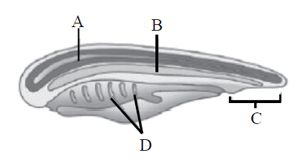
A. A-Notochord; B-Post-anal part; C-Gill slits; D-Nerve cord
B. A-Nerve cord; B-Notochord; C-Post-anal part; D-Gill slits
C. A-Notochord; B-Nerve cord; C-Gill slits; D-Post-anal part
D. A-Gill slits; B-Post-anal part; C-Nerve cord; D-Notochord
Answer : B

A. A-Notochord; B-Post-anal part; C-Gill slits; D-Nerve cord
B. A-Nerve cord; B-Notochord; C-Post-anal part; D-Gill slits
C. A-Notochord; B-Nerve cord; C-Gill slits; D-Post-anal part
D. A-Gill slits; B-Post-anal part; C-Nerve cord; D-Notochord
Answer : B
Sharing is caring
Related Post
Building Construction 1000+ MCQ with answer for SSC JE
GMAT - Choosing the correct sentence 1000+ MCQ [Solved] PDF Download
Design of Steel Structures 1000+ MCQ with answer for ISRO Recruitment
Windows 2000 Server MCQ Solved Paper for NDA
Compressors, Gas Turbines & Jet Engines 1000+ MCQ with answer for ESIC
SSC GD - Puzzle 1000+ MCQ [Solved] PDF Download